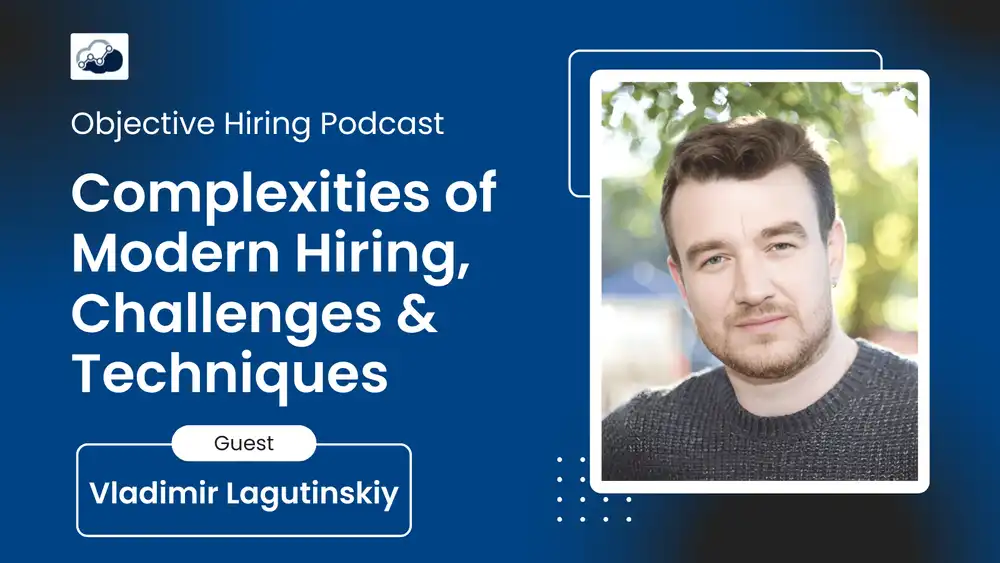Vladimir Lagutinskiy on Fixing What’s Broken in the Hiring Process

Vladimir Lagutinskiy on Fixing What’s Broken in the Hiring Process
Hiring is broken—but it doesn’t have to stay that way.
In a sharp, honest episode of the Objective Hiring podcast, Tim Freestone, founder of Alooba, sat down with Vladimir Lagutinskiy, Head of Data, to unpack some of the biggest flaws in how companies hire today. From CV screening that gives poor signal to the complete absence of feedback, the conversation called out what isn’t working—and pointed to ways to fix it.
“You’re applying and you’re never hearing back. And if you are, it’s just: Sorry, we’re moving forward.”
Vladimir’s insights reflect what many candidates and hiring teams already feel: the current process isn’t fair, efficient or effective. But there are ways to improve it—and it starts with changing how we think about candidates, skills, and systems.
The Feedback Void
One of the most damaging parts of modern hiring is the lack of feedback. Candidates submit applications, sometimes interview, and then hear nothing. Or worse, they get a generic rejection email that gives no information at all.
“It’s basically a copy-paste rejection. You don’t know what you did wrong. You don’t know how to improve.”
This not only frustrates candidates—it erodes trust in the company’s hiring process. It also removes a key learning opportunity. Without feedback, candidates can’t adjust or improve. And without improvement, the quality of future applicants doesn't get better either.
The Signal Problem
Much of the hiring process is built on weak signals: CVs, keyword matches, vague job titles and inflated summaries. According to Vladimir, this kind of signal is only getting worse.
“There are people who are fantastic at writing CVs. And there are people who are fantastic at the job. They’re not always the same people.”
This disconnect leads to poor outcomes: great candidates get filtered out early, while polished but underqualified applicants make it through. The result? Wasted time, high drop-off in later stages, and bad hires.
Too Much Noise, Not Enough Insight
Hiring managers today are often drowning in applications, especially for entry-level or generalist roles. But the tools to filter those applications aren’t keeping up.
“There’s just so many applications now, especially with remote roles. And there’s very little insight into who is actually good.”
This volume creates a bottleneck. HR or talent teams become gatekeepers without the resources or tools to fairly assess candidates at scale. And that can lead to rushed decisions, missed talent, and biased filters.
Practical Solutions Companies Can Adopt
Despite the problems, Vladimir doesn’t believe it’s all doom and gloom. There are clear ways companies can improve their hiring practices—starting with fairness, transparency and better tools.
1. Introduce Skill-Based Assessments
Vladimir is a strong advocate for assessing what candidates can actually do, rather than what their CV says.
“If I can test someone on the skills they need, I don’t care if their CV looks perfect. I care if they can do the job.”
Platforms like Alooba help companies move to skills-first hiring by letting candidates prove their ability through structured, objective assessments. It’s a way to reduce reliance on surface-level signals and give everyone a fair shot.
2. Provide Feedback (Even If Automated)
Vladimir points out that even basic, automated feedback is better than none at all.
“Just telling someone: you didn’t make it because you missed the minimum score in X—that’s already useful. It’s something.”
Providing context helps candidates understand the process, improves their experience, and builds trust. It also reduces the chance of disengaged or frustrated applicants in future roles.
3. Shorten Time-to-Decision
Delays in the hiring process are painful for everyone involved. Vladimir suggests that companies should aim to move faster by focusing on the right signals early.
“If I have a good assessment and a clear view of someone’s ability, I don’t need to run 5 more interviews. I can decide faster.”
Reducing unnecessary interview rounds and relying on structured skills data can help speed things up significantly.
4. Build Candidate Relationships—Not Just Filters
Hiring shouldn’t be a one-off decision. Companies that build relationships with strong candidates—even those who didn’t make the cut—will have a stronger pipeline in the future.
“You might not hire them today. But if you give a good experience, they might apply again. Or recommend you.”
What a Better System Looks Like
When asked how he’d fix the hiring process if he had a magic wand, Vladimir’s answer was simple but powerful: clarity and fairness.
“Everyone should know why they were rejected, and what they need to improve. That alone would make the process better.”
Hiring doesn’t have to feel like a black box. Companies can redesign their processes around real data, skill validation and candidate communication. It doesn’t require huge budgets—just a commitment to doing it better.
If your hiring process feels broken, Alooba offers a fresh approach. Fair assessments. Real signals. Less fluff. Try it for yourself.